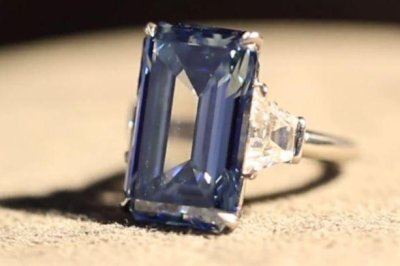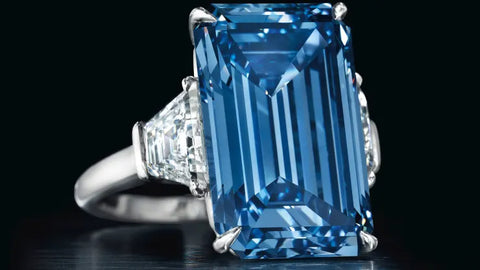The Oppenheimer Blue Diamond: Legacy, Rarity, and Splendor

Oppenheimer Blue Diamond // Christie's
The world of diamonds is filled with tales of allure, magnificence, and legends. Among the select few diamonds that have captured the world's attention, the Oppenheimer Blue diamond stands out, not just for its intrinsic beauty but also for the rich history attached to it. Let's embark on a journey to understand the essence of the Oppenheimer Blue diamond - its significant owners, the story that wraps it, its gemological and geological details, and its journey across auction houses.
The Significant Owners
The diamond's namesake, Sir Philip Oppenheimer, was its most famed owner. Born into the illustrious Oppenheimer family, Sir Philip's destiny in the diamond industry was almost preordained, given the family's deep-seated roots in the trade.
The Oppenheimer family's association with diamonds spans multiple generations. Their involvement began in the early 20th century when Sir Ernest Oppenheimer, Sir Philip's father, founded the Anglo American Corporation, a multinational company dealing with natural resources and associated industries. Ernest's prowess in the diamond trade soon became evident, leading to his election as the Mayor of Kimberley (a key diamond mining town) and subsequently, his pivotal role in the establishment and rise of the De Beers Consolidated Mines in 1929.
De Beers, under the Oppenheimer aegis, grew to control a vast majority of the world's diamond trade, and its monopoly was unchallenged for most of the 20th century. Sir Philip himself held a significant position within this empire, leading the Diamond Trading Company (a division of De Beers). Under his stewardship, De Beers maintained its position at the zenith of the diamond industry, ensuring that diamonds remained symbols of luxury and desire.
One of the shining testaments to the Oppenheimer family's legacy in the diamond world is the Oppenheimer Blue diamond. This gem, one of the most magnificent blue diamonds ever discovered, was named in honor of Sir Philip, who once had ownership of it. The diamond's allure, combined with its association with Sir Philip, amplified its fame, making it a symbol of both nature's beauty and the Oppenheimer legacy.
The legacy of the Oppenheimers in the diamond industry isn't just about dominance but also about setting standards, defining markets, and creating the allure around diamonds. From the famous marketing campaigns such as "A Diamond is Forever" to establishing the parameters for diamond trade, their influence is profound and lasting. Sir Philip Oppenheimer, with his sharp acumen and dedication, played a pivotal role in shaping this legacy.
Before coming into the hands of Sir Philip, the exact lineage of the diamond's owners remains a tad mysterious, a common trait for many such legendary gemstones. However, its association with the Oppenheimer family is what added significant weight to its legend.
The Story Behind the Diamond
As with many ancient diamonds, exact details of the Oppenheimer Blue's origins are nebulous. It is known to come from South Africa's diamond mines, most probably the Premier Mine, which has given the world several other legendary diamonds.
While the early journey of the diamond remains shrouded in some mystery, its later life is what has made it famous. The intense blue hue of the diamond, combined with its notable size, caught the attention of gem enthusiasts and collectors alike.
Gemological and Geological Details

Oppenheimer Blue Diamond Ring // Christie's
The Oppenheimer Blue diamond boasts a "Fancy Vivid Blue" color, a categorization by the Gemological Institute of America (GIA). The "fancy vivid" designation is the highest given for colored diamonds, denoting a pure and strong color. Blue diamonds owe their color to the presence of boron within their structure.
The diamond weighs an impressive 14.62 carats, making it one of the largest diamonds of its kind. Its emerald cut further magnifies its beauty, allowing the depth of its color to shine through. This particular cut is known for its stepped facets, which produce a hall-of-mirrors effect, making the inherent color of the gem more pronounced.
Geologically, diamonds are formed deep within the Earth's mantle under extreme temperature and pressure. They are brought closer to the surface through volcanic eruptions. The presence of boron, which gives the blue hue, suggests unique geological conditions during its formation, making blue diamonds not just rare but also a subject of intense geological interest.
Auctions and Sale

A Christie's employee holds up the Oppenheimer Blue Diamond Ring // Martial Trezzini / Keystone via AP
The Oppenheimer Blue diamond's entrance to the public eye came in 2016 when it was placed up for auction at Christie's Geneva. The auction world watched in rapt attention as bids were placed for this illustrious gem.
The result was staggering. The diamond fetched a price of $57.5 million, making it the most expensive jewel ever sold at auction at that time. The value of the diamond was not just in its carat weight or color but also in its association with the Oppenheimer name, and the rarity of such blue diamonds.
Current Value
Estimating the current value of the Oppenheimer Blue diamond is challenging. The world of diamonds and collectibles is subject to fluctuations based on demand, rarity, and global economic conditions. Given its last known price in 2016, and factoring in inflation, increased appreciation for blue diamonds, and its historical significance, it is reasonable to estimate that its current value could exceed its last known sale price considerably. However, the exact figure would only be known if and when the diamond is presented for sale or auction again.
Conclusion
The Oppenheimer Blue diamond is not just a gemstone. It is a piece of history, a work of art by nature, enhanced by its cut, and immortalized by its association with the Oppenheimer legacy. Its journey from the depths of the Earth to the hands of esteemed owners and the echelons of auction houses tells a story of beauty, rarity, and unmatched value.

Leave a comment